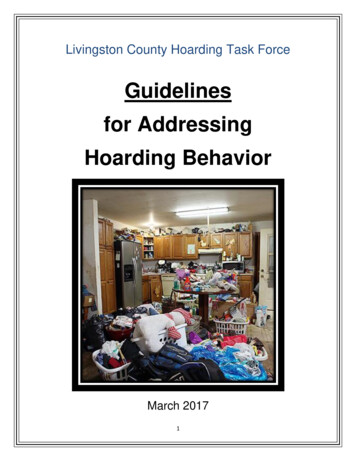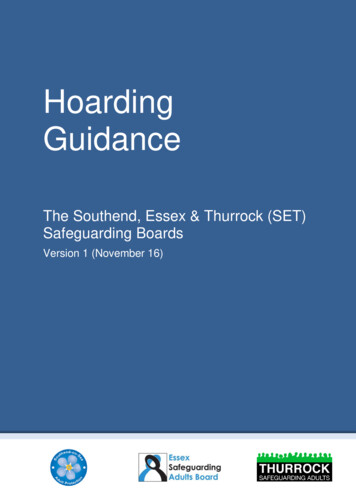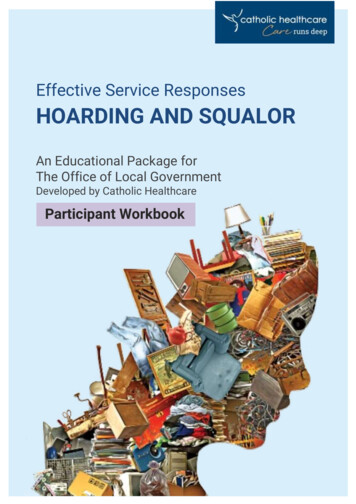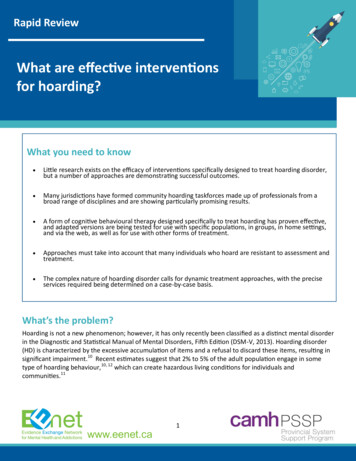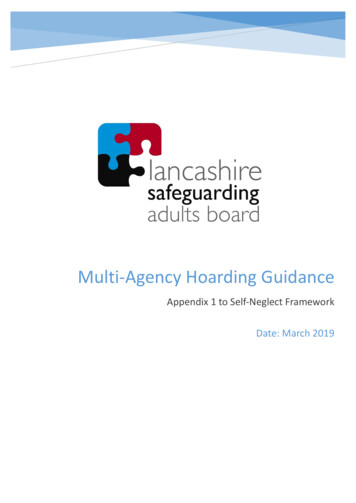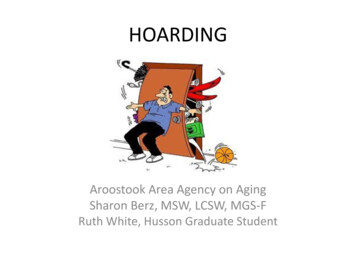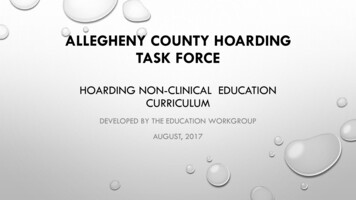
Transcription
ALLEGHENY COUNTY HOARDINGTASK FORCEHOARDING NON-CLINICAL EDUCATIONCURRICULUMDEVELOPED BY THE EDUCATION WORKGROUPAUGUST, 2017
INTRODUCTION The Allegheny County Hoarding Task Force is a collective group of individuals working to accomplish themission of the Task Force. The Task Force does not have and cannot accept funding and does not engage,intervene or consult on individual hoarding cases, concerns or situations. The mission of the Allegheny County Hoarding Task Force is to better understand the nature and extent ofhoarding, increase education and awareness and coordinate community resources in Allegheny County, socommunity services are better able to respond to individuals with hoarding disorder. This document has been created by members of the Hoarding Task Force Education Workgroup. Informationin this document has been developed by its members through professional experience and research. Thisdocuments is not meant to replace professional or legal advice. It is a first step to learn a bit more aboutHoarding and Hoarding Disorder and the complex issues that are faced by people with this disorder.
AUDIENCE AND PURPOSE Target Audience: Community segments and organizations that do not exclusively work withindividuals with a hoarding disorder, but may come across hoarding in their line of work, such ascode enforcement, municipal workers, first responders, insurance industry employees among otherpopulations that are seeking more information about hoarding disorder. Purpose: Examine multiple components of hoarding, including hoarding disorder basic definitions,stages of hoarding, risk factors, safety and interaction.
TOPICS BACKGROUND AND DEFINITIONSDEBUNKING THE MYTHS OF HOARDINGCOMMON CHARACTERISTICS OF INDIVIDUALS WITH HOARDING DISORDER STAGES OF HOARDING RISK FACTORSCLEANUP/REMEDIATIONROADBLOCKS AND BARRIERS DANGERS SAFETYCONCLUSION REFERENCE
WHAT IS HOARDING? Hoarding is the excessive acquiring and accumulation of items along with a persistent inability to discard items because of a perceived needto save. These items may have little value or utility. The thought or action of discarding an item will cause discomfort and distress. Collecting VS. Hoarding Collecting – A person who collects items of a specified type, professionally or as a hobby. A collector differs from a hoarder in that a collectordisplays and cherishes their items while being able to set boundaries on their acquisitions and fully understand their collections actual value. Hoarding – Hoarding is the excessive acquiring and accumulation of items along with a persistent inability to discard items because of aperceived need to save. These items may have little value or utility. The thought or act of discarding an item will cause discomfort and distress.An Individual suffering from hoarding disorder has persistent difficulty discarding or parting with possessions, regardless of their actual value
COMMON CHARACTERISTICS Individuals with hoarding disorder are often stigmatized. The Hoarding Task Force Education Workgroup hasreflected on their experience working with individuals with hoarding disorder and developed the follow list ofcommon characteristics. Individuals with a hoarding disorder are often Visual learners Highly educated Creative Passionate Have strong environmental concerns Enjoy giving to others Enjoy reading literature
DEBUNKING THE MYTHS OF HOARDING THIS SECTIONS DISPELS COMMON MYTHS ABOUT INDIVIDUALS WITH HOARDINGDISORDER. INFORMATION IN THIS SECTION WAS DEVELOPED BASED ON DISCUSSION WITH PROFESSIONALSON THE HOARDING TASK FORCE EDUCATION WORKGROUP BASED ON THEIR EXPERIENCES.
HOARDING STEREOTYPES V. REALITYHoarding StereotypeHoarding RealityHoarded homes are filthy.Not all hoarded homes are filthy. Many hoarded homes are organized andclean.All hoarding homes have bugs and vermin.Many hoarded homes do not have an infestation.People who hoard are poor.Hoarding affects people of all socio-economic status and backgroundsPeople who hoard are lazy.Individuals who suffer from hoarding disorder often struggle withdepression. This makes doing everyday tasks very difficult.People who hoard are agoraphobic and/or anti-social.A lot of people who hoard have a community and family who love them.People who hoard are overweight.Individuals who suffer from hoarding disorder come in all shapes andsizes.People who hoard are uneducated.Most individuals who hoard not only have an education but often have hadwell-paying jobs either in the past or present.
STAGES OF HOARDINGHoarding disorder is chronic and progressive, meaning hoarding is likely to increase over time. The ClutterRating Scale is used to determine the extent of clutter. For more information about this scale please clickon the link below. The clutter Rating Scale uses 9 stages, however in the descriptions below a 1 to 5 scale isused, with stage 1 being least advanced and stage 5 most advanced. The categories below outline the stages of hoarding. Click the link below to access the Institute forChallenging Disorganization Clutter Rating Scale for more detail: lutter-8211-hoarding-scale
STAGES OF HOARDINGStage 1Stage 1 following the Clutter Rating Scale is the least advanced level of hoarding. At this stage hoardingbehavior and habits become solidified.Below are common characteristics that may present in stage 1 All doors and stairways are accessible All amenities are accessible and working Functioning bathroom and clean clothes All family members and pets are healthy, clean, and well nourished Maintained finances Invites friends’ over Not generally viewed as a hoarder Feelings of anxiety about their clutter, with minimal effects
STAGES OF HOARDINGStage 2In stage 2, indicators of hoarding become more identifiable. Safety issues are starting to arise and impairedfunctioning is starting to present, including accessibility and mobility constraints. One exit to the house is blocked or one room is unusable One major appliance is not in working order because it is too difficult to access Less attention is being paid to housekeeping. (e.g. Dishes are piling up and shelves remain dusty) Pet odors becoming noticeable. Shift in focus from life to clutter. Diminished social and family interaction Reduction in the number of guests they have over because of embarrassment Mild anxiety and depression Shifting from embarrassment to justification
STAGES OF HOARDINGStage 3Stage 3 is the mid-point on the Clutter Rating Scale and signs of hoarding are starting to become evident tooutsiders. Indoor items may be stored or tossed outside Minor structural damage Evidence of excessive extension cord use and phone lines when outlets get blocked off Pets may have fleas The kitchen sink may be full of dishes and standing water Stairs and walkways are generally extensively cluttered and difficult to navigate Outside storage (shed or garage) is overflowing Personal care is neglected Consuming reheated, precooked, or fast food because the kitchen is only borderline functional Decreased physical activity Family has attempted to intervene numerous times and is faced with rejection and withdrawal. Work place problems Growing financial concern
STAGES OF HOARDINGStage 4Stage 4 consists of advanced structural damage in several areas, including sagging floors and ceilings.Major appliances are no longer working properly or at all. The house and contents pose a significant safetyrisk to occupants.Additionally, individuals will not have access to fresh foods and safe/workable food preparation area andutensils. Mold, bugs, and cobwebs may be present Contents are stored in uncommon places such as clothes hanging on the shower curtain rod orimportant documents in the oven Individuals who hoard will remain in very small area of the house, “The Cockpit” Bathe in the sink or not at all Struggle to get to work on time or no longer working Significantly behind on bills and other serious financial troubles Utilities may be shut off Pets may have run away or died in the house Individuals may have shut everyone out of their lives
STAGES OF HOARDINGStage 5Stage 5 is the most advanced and profound stage. Hoarding is evident and the property is highly unsafe andinhabitable. Major structural damage to the house Severe mold, strong odors, bugs, rodents, and cobwebs Entire floors of the house might be blocked off Walls of items in every room Struggling to complete simple tasks like eating, sleeping, using the restroom Limited to consuming soft drinks, fast-food or expired foods Family and friends (if they are still in contact with them) are deeply concerned Serious financial problems Severe, debilitating depression Confusion Isolated to their house, unless it is to move into their car or a homeless shelter
HOARDING DISORDER RISK FACTORSIdentify risk factors (antecedents) that may lead an individual to hoard.These factors may be a combination of physical, psychological and environmental.Information in this section is developed from conducting a literature review of hoarding risk factorsand reviewing professional experiences working with individuals with hoarding disorder.
HOARDING DISORDER RISK FACTORSAGEHoarding appears more commonly in older individuals, as the disorder is progressive. Hoarding is likely to have started at a much earlier period of life, however the effects may notbe observed until the individual is older. The Mayo Clinic reports hoarding usually starts around age 11 to 15 and progresses throughout life.DEMENTIA Dementia creates changes in the brain that can lead to hoarding, according to the Alzheimer’s Association. They also report hoarding may develop in the early and middle stagesof dementia. Like other individuals that hoard, individuals with dementia Forget to discard things Have difficulty distinguishing items that should be kept or discarded Have difficulty remembering where items are stored, placed or hiddenDEPRESSION AND ANXIETY 50% of clients with hoarding disorder have a major depressive disorder as well.SOCIAL PHOBIA AND ISOLATIONPeople with hoarding disorder are more likely to be socially isolated. Their past experiences have caused them to distrust people and they find interacting with people often causesemotional or physical pain. Individuals who hoard may prefer material comfort.
HOARDING DISORDER RISK FACTORSPERSONALITY AND DECISION MAKING According to the Mayo Clinic, individuals that have hoarding disorder may be more indecisive, taking longer tomake a choice to throw away or keep an item Suffer from chronic disorganization which makes deciding very difficult since they are unable to clearly outline apurpose and need for an itemTRAUMA AND STRESSMost Individuals who struggle with hoarding have a history of trauma. As a means of coping with the past, individualsseek comfort in possessions. Sometimes these possessions create a physical barrier between them and the persons orworld that harmed them. Other times folks who have suffered abuse, neglect, or rejection turn their affections towardsitems and the joy that they bring serves as a substitute in for healthy interpersonal relationships.
CLEAN UP AND REMEDIATIONClean-out can be a very stressful situation for an individual who hoards. Because ofthe emotional attachment to the items, this can a very vulnerable time for theclient. When helping a loved one processing their items, it is important to allow theclient to make the majority of the decisions on their own. This process requirescompassion, patience, and understanding on the part of the individual assisting theclient.
CLEAN UP AND REMEDIATIONUnfortunately, if a clean-up requires professional services, these can often be costly. A clean-up could cost upward of 5,000 or more, but is very situationalSome considerations: If biohazards of present Property size Property condition Property location Property/utility damage Level of client involvement
ROAD BLOCKS AND BARRIERS TO TREATMENTThere are many road blocks and barriers preventing clients from successfullyaccessing, receiving and progressing through the treatment and clean-upprocess.Information in this section was developed through common research andmembers of the Hoarding Task Force reflecting on common road blocks andbarriers they have identified as part of their professional experiences.
ROAD BLOCKS AND BARRIERS TO TREATMENTMoney and Finances Money is a common barrier to treatment. Individuals that hoard may not be financially equipped to engage in an intensive clean outprogram. A clean-up could cost around 5,000 or more. If an individual is covered by health insurance, they may be able to access therapy services. Health insurance will not cover the cost ofcleanup and remediation.Client Self-insight Clients may lack full insight into the extent of their hoarding situation and may be unready and unwilling to improve their situation. Somemay be unable to comprehend the size of their clutter and feel their issues are more related to a lack of space or lack of organization. No insight - No awareness; denial and justification of one’s hoarding situation. Believes hoarding behavior and situation is not problematic Partial insight Some awareness of one’s situation, causes and consequences. Mostly believes hoarding behaviors are not problematic. Full insight - Good awareness of one’s situation and causes, effects and consequences. Person can accurately explain and describe their situation.
ROAD BLOCKS AND BARRIERS TO TREATMENTPhysical Ability Individuals who hoard may not have physical ability to clean up because of advanced age, fragility or physical disability. Individuals should be encouraged to participate to theirfull potential and be an active member in the cleanup process.Support Hoarding is often isolating. Many individuals that hoard are ashamed and embarrassed and hide their situation from others. Lack of support can lead to isolation, depression,anxiety among many other issues.Stigma and Discrimination The stigma of having a hoarding disorder may be at the core of why an individual does not seek treatment. With the way, the disorder is negatively portrayed in the media, anindividual may be more comfortable hiding the illness and withdrawing from those around them, rather than becoming vulnerable to critics. Special care and sensitivity needs to betaken to engage an individual to accept services.Transportation and Community Access Access includes transportation and physical and community access. Individuals in rural areas may not have access to public transportation. An individual may have to drive an hour or more to be able to receive support, treatment or socialization.
LEGAL SUPPORT Individuals diagnosed with hoarding disorder are protected under the Americans with Disabilities Act (ADA). Individuals with a hoarding disorder diagnosis are entitled to reasonable accommodation. Contact your local legal aid organization or ADA coordinator for additional information. If the safety of children, older/vulnerable adults is suspected or in question, contact the appropriate protectiveservice agency. Protective Service Contact Numbers: Children Protective Services1-800-932-0313 n.aspx Older Adults Protective Service Services/About/Contact/Older-Adult-Abuse.aspx
SAFETY AND PRECAUTIONSHoarding situations require special safety measures. safety precautions can be used to mitigate risks ina hoarding situation. Each hoarding situation is unique, so understanding the extent and degree ofhoarding is important. Some hoarding situations may be advanced, with mold, dead or alive animals,including urine and droppings. Additionally, structural integrity issues and fire risks are increased.Please note that hoarding clean up may require specialized services, such as mold remediation andhazardous waste management. It is important to seek these services when appropriate and not riskpersonal safety.Information in this section was identified through primarily researching Centers for Disease Control andPrevention publications other web-site based resources.
ANIMALS / VERMINAnimals and vermin may be present in hoarding situation.It is important to understand animal hoarding is different from attracting animals and vermin.Animal hoarding is distinctly acquiring animals.Vermin and pestsOther non-domesticated animalsDomesticated animalsVermin is defined as a small, common, harmful or objectionable animal (as lice or fleas) that are difficult to controlRaccoons, bats, feral cats and dogs may inhabit a severely hoarded property and potentially carry disease, includingrabies.In a severely hoarded home domesticated animals may become trapped under debris or unable to access fresh food andwater, a result the animals will run away or die.
STRUCTURAL DAMAGEFire hazardsUnstable surfacesInaccessible exitsAccumulation of flammable and combustible materials in excess possess a fire hazard. Evacuation andrescue during a fire or other emergency may be compromised because the level of hoard. Some hazardsinclude: Multiple extension cords Overloaded outlets Blocked heating vents Improper use and maintenance of appliances Damage to electrical system Occupant smoking without precautionDepending on the extent of a hoarding situation, walking paths may be cluttered with debris, creating trippinghazards and affect balance.Many hoarded properties are at an increased fire risk. In the event of a fire or need to evacuate, exits may not beeasily accessible or usable.Individuals with mobility impairments may be in particular dangerRisk of collapse/entrapmentPiles of clutter may collapse/cave in and/or shift, especially when disturbed by humans and animals.Gas lines, electrical sources may be damaged, leading to shock and fire hazards.Damaged utilitiesWater and sewage pipes may be damaged, especially in older properties with brittle lead piping.
PRECAUTIONS AND PERSONAL PROTECTIVEEQUIPMENT Precautions should be taken and Personal Protective Equipment (PPE) used as appropriate toreduce risk of infection and contact with hazards in a hoarding situation. The type of interaction,hoarding severity and hoarded content will inform the precaution and equipment that should beused. The following precautions and PPE should be available to use in a hoarding situation. Information in this section is gathered through web-based research. Information in this section isused or general knowledge and each situation is unique and this document is not a comprehensivemanual that addresses safety. It is designed to provide a general overview.
PRECAUTIONS AND PERSONAL PROTECTIVEEQUIPMENTStandard PrecautionsStandard precautions should be taken when entering a hoarded property. Proper judgement should be used regarding the level of precaution needed.The following are some examples of precautions that could be taken in a hoarding situation. Proper hand washing Ventilate work area as possible Change of clothes and change clothes before returning to personal residence.Personal Protective Equipment (PPE)Personal Protective Equipment, (PPE) equipment is used to protect an individual from possible hazards by creating a barrier between the environment and person.Some important PPE items are listed below Durable work gloves Shoe covers Goggles/face shield Respirator/mask (two strap, N – 95) Protective gown Closed toed shoes
ENTERING A HOARDED PROPERTYCAREGIVERS AND PROFESSIONALS THAT ENTER THE HOME ARE SUBJECT TOHEALTH AND SAFETY CONCERNS.THE FOLLOWING ARE IMPORTANT STEPS TO CONSIDER TO SAFEGUARD YOURSELF Take only essential items with you. Place personal belongings into a plastic bag, seal it, and leave it near the door, to be picked up when exiting. Consider bringing a change of clothes in more severe circumstances. Avoid wearing loose fitting clothing, open-toed shoes, or shoes with deep treads that could hold pests or unsanitary debris. Consider using protectiveequipment (gloves, boots, gown, mask) in more concerning environments while weighing the impact this may have on the therapeutic alliance. Avoid sitting, particularly on soft-covered furniture. Do not lift, carry, or walk into areas you do not feel comfortable accessing. Be aware of your exits and paths. Avoid areas where piles can easily topple.
ENTERING A HOARDED PROPERTYCLIENT SAFETYIt is important hoarding client’s safety be considered. The client’s level of insight will influence the mitigating safety factors the client is willingto take. Two accessible exits in every rooms Smoke AND carbon monoxide detector Emergency response system, when indicated Working and accessible landline/cell phone Area to store and prepare foods safely Working bathroom Working utilities
ENTERING A HOARDED PROPERTYCommunity and Public Health ConcernsHoarding in apartments and closely constructed homes create dangers for the community in addition tothe individual that hoards. Community safety is affected because the consequences and risks of hoardingare often not easily confined.Some examples of community risks include: Water damage Odors Fire Infestation of bugs, fleas, and other animal and pests that may travel outside the apartment/home.
FIRST RESPONDERSWhen responding to an emergency, first responders are faced with increased safety risks in hoardedproperties. Hoarded homes may not have direct paths and ingress/egress that prevent emergencyresponders from successfully carry out their duties. Hoarding situations create a substantial risk toboth occupants and responders.
FIRST RESPONDERSFIRE RESPONDERSEntering a hoarded home that is on fire is extremely dangerous for fire personnel. Hoarded homes maycontain many flammable items creating an explosion risk. The fire may also weaken piled of hoardingitems, creating cave-ins and entrapment risks. Individuals that are trapped in a hoarded home that isconsumed by fire are less likely to be rescued. Hoarding situations reduce the ability of fire personal tocontrol the fire and preserve further property damage. Hoarding may increase the speed which firespreads because the abundance of combustible material to serve as a fuel source.
CONCLUSION There is a void in academic literature and research on hoarding disorders. Insurance will only pay for treatmentsthat are “evidence based”, meaning they have been well researched treatments and proven to work. With little research on the topic of hoarding comes minimal approved treatments. This also affects the availabilityof funding for those struggling with this disorder. Hoarding disorder research needs to be made a priority. As community members, we can advocate for more funding to be directed to hoarding disorder research andprograms that assist those struggling with hoarding. Raising awareness and destigmatizing this disorder helps createan environment where those who once struggled silently can confidently reach out for help.
SOURCESAlzheimer’s Association (December, 2015) Rummaging, Hiding and Hoarding Behaviors. St. Louis Chapter. Retrieved maging.pdfAmerican Psychiatric Association. Diagnostic and Statistical Manual of Mental Disorders: Fifth Edition (DSM-5)Chater, C Shaw, J & McKay, S. (2013, March) Hoarding in the Home: A Toolkit for the Home Healthcare Provider Retrieved line/Pages/articleviewer.aspx?year 2013&issue 03000&article 00006&type FulltextCenters for Disease Control and Prevention. (2016, May 3) Botulism Retrieved from: https://www.cdc.gov/botulism/index.htmlCenters for Disease Control and Prevention. (2017, January 24) How People Get Hantavirus Pulmonary Syndrome. Retrieved ers for Disease Control and Prevention. (2016, Dec 30) Salmonella Retrieved from: https://www.cdc.gov/salmonella/index.htmlCenters for Disease Control and Prevention (2016, May) Norovirus Retrieved from: https://www.cdc.gov/norovirus/index.htmlFrost, R. (2012, Sept, 14) Hoarding: Making Disorder an Official Disorder. Smith College. Retrieved r.phpFrost, R.O, Steketee, G, and Tolin, D.F. (2011, Jul 18) Comorbidity in Hoarding Disorder. Retrieved risham, J.R. & Baldwin, P.A. (2015, April 2) Neuropsychological and Neurophysiological Insights into Hoarding Disorder. Neuropsychiatric Diseaseand Treatment. Dovepress. Retrieved from: -reviewed-fulltext-article-NDTHoarders Anonymous. (2013). Levels of Hoarding. Retrieved from: http://www.hoardersanonymous.org/facts.htm
SOURCESHuppert, J. D., & Roth, D. A. (2003). Treating obsessive-compulsive disorder with exposure and response prevention. TheBehavior Analyst Today, 4(1), 66-70. http://dx.doi.org/10.1037/h0100012Kohler, K. (2017) Personal communicationLussier, M.T & Richard, C. (2007, Dec 12) The Motivational Interview: In practice. The College of Family Physicians ofCanada. Retrieved from: 47/Mataix-Cols, D. (2014, May 22) Hoarding Disorder New England Journal of Medicine. Retrieved 13051Mayo Clinic Staff (2014, July 24) Toxoplasmosis. Mayo Clinic. Retrieved from: lasmosis/basics/definition/CON-20025859Mayo Clinic Staff (2014, August, 01) E. Coli Mayo Clinic. Retrieved from: i/basics/definition/CON-20032105Mayo Clinic Staff, (2014, May 8) Hoarding Disorder. Mayo Clinic. Retrieved from: ing-disorder/basics/definition/con-20031337Miller, W and Rollnick, S. (2012, Sept, 7) Motivation Interviewing: Helping people change. 3rd ed. The Guilford Press
SOURCESSamuels, J., et al, (2007). Significant linkage to compulsive hoarding on chromosome 14 in families with obsessivecompulsive disorder: Results from the OCD collaborative genetics study. American Journal of Psychiatry, 164(3), 493499. Retrieved from Https://www.ajp.psychiatryonline.orgShaeffer, M (2012, May) A Social History of Hoarding Behavior. Kent State University., Retrieved from:https://etd.ohiolink.edu/rws etd/document/get/kent1333842460/inlineSnowdon, J., Halliday, G., & Banerjee, S. (2012). Severe Domestic Squalor (1st ed.). New York, NY: Cambridge UniversityPress.Szalavitz, M. (2012, Aug 7) Inside the Hoarder’s Brain: A unique problem with decision-making. Retrieved making/Yalom, I. (2005) The Theory and Practice of Group Psychotherapy. 5th ed. Basic Books.
Hoarding disorder is chronic and progressive, meaning hoarding is likely to increase over time. The Clutter Rating Scale is used to determine the extent of clutter. For more information about this scale please click on the link below. The clutter Rating Scale uses 9 stages, however in the descriptions below a 1 to 5 scale is
